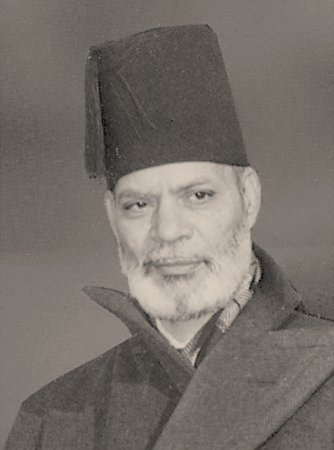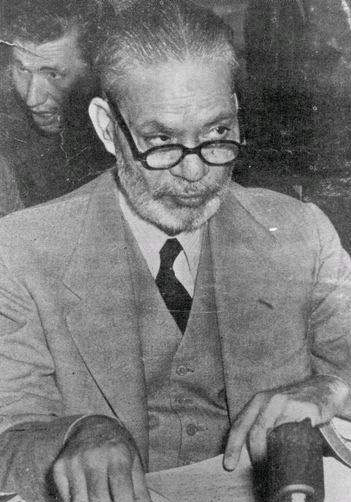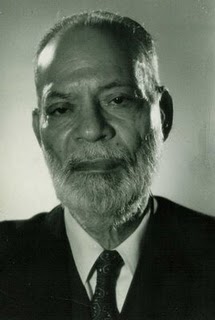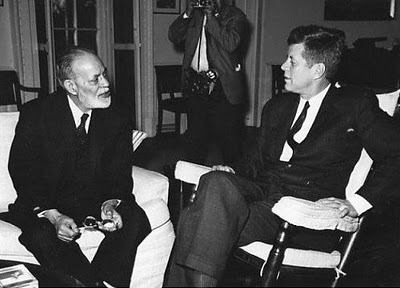<Back to Index>
- Physician William Parry Murphy, 1892
- Poet Évariste Desiré de Forges, vicomte de Parny, 1753
- Foreign Minister of Pakistan Mohammad Zafarullah Khan, 1893
PAGE SPONSOR



Sir Muhammad Zafarullah Khan, KCSI (February 6, 1893 - September 1, 1985) was a Pakistani politician, diplomat, international jurist, and scholar of the Ahmadiyya Muslim Community, known for drafting the Pakistan Resolution, for his representation of Pakistan at the United Nations, and serving as a judge at the International Court of Justice in The Hague.
The son of the leading attorney of his native city Sialkot, Zafarullah Khan studied at Government College, Lahore, and received his LL.B. from King's College London, in 1914. He practiced law in Sialkot and Lahore, became a member of the Punjab Legislative Council in 1926, and was a delegate in 1930, 1931, and 1932 to the Round Table Conferences on Indian reforms in London, England. In 1931 – 1932 he was president of the Muslim League, and he sat on the British Viceroy's Executive Council as its Muslim member from 1935 to 1941. He led the Indian delegation to the League of Nations in 1939, and from 1941 to 1947 he served as a judge of the Federal Court of India.
Prior to the partition of India in 1947, Zafarullah Khan drafted the Pakistan Resolution and presented the Muslim League's view of the future boundaries of Pakistan to Sir Cyril Radcliffe, the man designated to decide the boundaries between India and Pakistan. Upon the independence of Pakistan, Zafarullah Khan became the new country's minister of foreign affairs and served concurrently as leader of Pakistan's delegation to the United Nations (1947 – 1954). From 1954 to 1961, he served as a member of the International Court of Justice at The Hague. He again represented Pakistan at the United Nations (1961 – 1964) and served as president of the UN General Assembly in 1962 to 1963. Returning to the International Court of Justice in 1964, he served as the court's president from 1970 to 1973.
Muhammad Zafrulla Khan was elected a member of the Punjab Legislative Council in 1926 and presided at the Delhi Meeting of the All-India Muslim League in 1931, where he advocated the cause of the Indian Muslims through his presidential address. He participated in the Round Table Conferences held from 1930 to 1932 and became the Minister of Railways in May, 1935. In 1939, he represented India in the League of Nations. He was appointed the Agent General of India in China in 1942 and represented India as the Indian Government's nominee in the Commonwealth Relations Conference in 1945, where he spoke India's cause for freedom.
From 1935 to 1941, he was member of the Executive Council of the Viceroy of India. During this period, Viceroy Lord Linlithgow, told the leaders of the Muslim League that the Government of Great Britain intended to divide India in three dominions: one for the Hindus, Muslims, and Rulers of Princely States. Within the Muslim League Working Committee, various sub-committees were established, numerous proposals were presented with the final decision resting with the British. However, when the British saw that their objectives could not be met, they unilaterally rejected all proposals submitted by the Muslims. At that point, Zafarullah Khan was asked to submit a proposal on the partition of India. On that subject, the Viceroy wrote the Secretary of State for India:
Upon my instruction Zafarullah wrote a memorandum on the subject. Two Dominion States. I have already sent it to your attention. I have also asked him for further clarification, which, he says, is forthcoming. He is anxious, however, that no one should find out that he has prepared this plan. He has, however, given me the right to do with it what I like, including sending a copy to you. Copies have been passed on to Jinnah, and, I think, to Sir Akbar Hydari. While he, Zafarullah, cannot admit its authorship, his document has been prepared for adoption by the Muslim League with a view to giving it the fullest publicity.
— Lord Linlithgow, April 12, 1940
The Viceroy further explained that since Zafarullah Khan was a member of the Ahmadiyya Muslim Community, he had to be cautious. The Muslims would become irritated if they found that this proposal was prepared by an Ahmadi. The Viceroy said that Muhammad Ali Jinnah had been given a copy to gain acceptance from the Muslim League and publicize its contents. Akbar Hydari was given a copy because he was responsible for fund raising. Twelve days after it had been proposed, the Muslim League adopted the proposal at the Lahore Conference, calling it the Pakistan Resolution.
In September 1941, Zafarullah Khan was appointed Judge of the Federal Court of India which he held until June 1947. At the request of Muhammad Ali Jinnah, he represented the Muslim League in July 1947 before the Radcliffe Boundary Commission and presented the case of the Muslims in a highly commendable manner. Zafrullah Khan advised the Nawab of Junagadh that if he decided to join his state with Pakistan, it would be both moral and legal. The Nawab then proceeded to announce his decision.
In October 1947, Zafrullah represented Pakistan in the United Nations General Assembly as the head of the Pakistan delegation and advocated the position of the Muslim world on the Palestinian issue. That year, he was appointed as Pakistan's 1st Foreign Minister, a post he held for 7 years.
In 1948 to 1954, he represented Pakistan at the United Nations Security Council and where he advocated the case of liberation of the occupied Kashmir, Libya, Northern Ireland, Eritrea, Somalia, Sudan, Tunisia, Morocco, and Indonesia.
In 1954, he became Judge of the International Court of Justice in The Hague,
which he held until 1961. He became the Vice President of the
International Court of Justice, the Hague, in 1958 and remained so
until 1961. Between 1961 to 1964, he was Pakistan's Permanent
Representative at the UN while at the same time, became President of the UN General Assembly in 1962 for 2 years. As an active member of the Ahmadiyya Muslim Community, Zafarullah Khan held the office of president of the Lahore, Pakistan branch of the community from 1919 to 1935. He served as Secretary to Khalifatul Masih II, the second successor of Mirza Ghulam Ahmad, at Majlis - e - Shura for
the first time in 1924, continuing for seventeen more sessions. In
addition, he was a member of the delegation which represented the
Ahmadiyya Muslim Community at the All Parties Conference held in 1924.
In 1927, he acted successfully as representative counsel for the
Muslims of the Punjab in the contempt of court case against the Muslim Outlook. As Pakistan's first Foreign Minister, Zafarullah Khan addressed the Constituent Assembly of Pakistan in the days leading up to passing of the Objectives Resolution. The Objectives Resolution, which combined features of both Western and Islamic democracy, is one of the most important documents in the constitutional history of
Pakistan. It was designed to provide equal rights for all citizens of
Pakistan, regardless of race, religion or background. Zafarullah Khan
was quoted saying: It
is a matter of great sorrow that, mainly through mistaken notions of
zeal, the Muslims have during the period of decline earned for
themselves an unenviable reputation for intolerance. But that is not
the fault of Islam. Islam has from the beginning proclaimed and
inculcated the widest tolerance. For instance, so far as freedom of
conscience is concerned the Quran says "There shall be no compulsion"
of faith... — Muhammad Zafarullah Khan, Addressing the Constituent Assembly of Pakistan, c. 1949 In March 1958, Zafarullah Khan performed Umrah while at the same time, visited the shrine of Muhammad in Medina, Saudi Arabia. During his visit, he met with the King of Saudi Arabia Ibn Saud of Saudi Arabia, staying in the Royal Palace as the King's personal guest. In 1967, Zafarullah Khan returned to Saudia Arabia to perform Hajj, a religious duty that must be carried out at least once in a lifetime by every able - bodied Muslim who can afford to do so.
After
having lived in England from 1973 to 1983, Zafarullah Khan returned to
Pakistan until his death in Lahore on September 1, 1985 due to a
protracted illness. He was buried in Bahishti Maqbara in Rabwah, Pakistan, a cemetery established by the Ahmadiyya Muslim Community.


